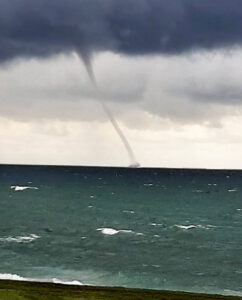There are two types of waterspouts: fair weather waterspouts and tornadic waterspouts.
A fair weather waterspout is a whirlwind that forms beneath a cumulus cloud and over water. It’s generally not associated with thunderstorms.
A fair weather waterspout develops on the surface of the water and moves upward. Before you see the waterspout, you may see a funnel cloud hanging from the bottom of the cumulus cloud. A waterspout forms as the rotating funnel draws up water.
Fair weather waterspouts form in light wind conditions so they tend to stay in one place.
The Florida Keys, Gulf of Mexico, and Chesapeake Bay are common regions for waterspouts.

They also occur over the Great Lakes. Between Sept. 28 and Oct. 4, 2020, there were 232 waterspouts over the Great Lakes. There was also another waterspout outbreak this year on the Great Lakes between Aug. 16 and Aug. 18, when the count was 88 spouts.
These large outbreaks resulted from a cold Canadian air mass moving over the Great Lakes. That increased the normal drop in temperature with height, making the air near the surface more prone to rising.
Severe thunderstorms that produce tornadoes that form over water or move from land to water become tornadic waterspouts. Tornadic waterspouts develop in the thunderstorm and move downward towards the ground.
Most fair weather waterspouts are much weaker than the weakest tornado. However, if you are in a boat and see one you should consider it dangerous. You can try to move away by steering your boat at right angles to its movement. If you can’t get out of the way, put on your lifejacket (which you should already have on) and protect yourself from flying debris.

